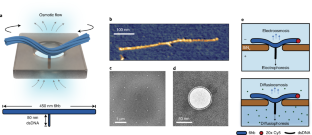2022-08-04 オランダ・デルフト工科大学(TUDelft)
フロー駆動モーターは、DNA材料でできています。この構造体は、薄い膜のナノ穴(小さな開口部)にドッキングされています。厚さわずか7ナノメートルのDNAの束は、電場下で自己組織化してローターのような形状になり、その後、毎秒10回転を超える持続的な回転運動に入ります。
ローターは、電圧をかけるか、あるいはもっと単純に、膜の両側の塩分濃度が異なることによって生じる水とイオンの流れからエネルギーを利用する。塩の流れは、生物学において最も豊富なエネルギー源のひとつであり、細胞燃料の合成や細胞の推進力など、さまざまな重要なプロセスに力を与えている。
<関連情報>
- https://www.tudelft.nl/en/2022/tu-delft/tu-delft-researchers-create-flow-driven-rotors-at-the-nanoscale
- https://www.nature.com/articles/s41567-022-01683-z
ナノ細孔上での自己組織化DNAローターの持続的な一方向回転 Sustained unidirectional rotation of a self-organized DNA rotor on a nanopore
Xin Shi,Anna-Katharina Pumm,Jonas Isensee,Wenxuan Zhao,Daniel Verschueren,Alejandro Martin-Gonzalez,Ramin Golestanian,Hendrik Dietz & Cees Dekker
Nature Physics Published:04 August 2022
DOI:https://doi.org/10.1038/s41567-022-01683-z

Abstract
Flow-driven rotary motors such as windmills and water wheels drive functional processes in human society. Although examples of such rotary motors also feature prominently in cell biology, their synthetic construction at the nanoscale has remained challenging. Here we demonstrate flow-driven rotary motion of a self-organized DNA nanostructure that is docked onto a nanopore in a thin solid-state membrane. An elastic DNA bundle self-assembles into a chiral conformation upon phoretic docking onto the solid-state nanopore, and subsequently displays a sustained unidirectional rotary motion of up to 20 rev s−1. The rotors harness energy from a nanoscale water and ion flow that is generated by a static chemical or electrochemical potential gradient in the nanopore, which are established through a salt gradient or applied voltage, respectively. These artificial nanoengines self-organize and operate autonomously in physiological conditions, suggesting ways to constructing energy-transducing motors at nanoscale interfaces.



